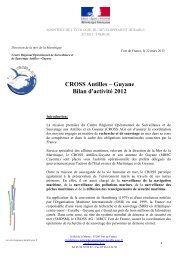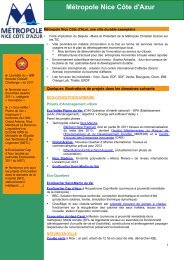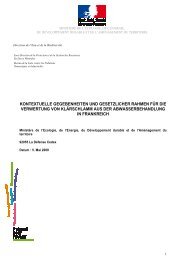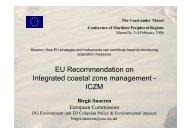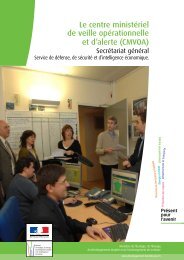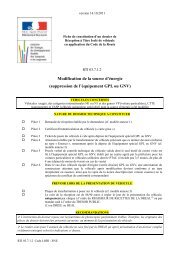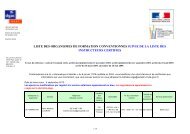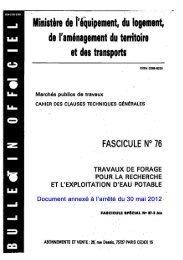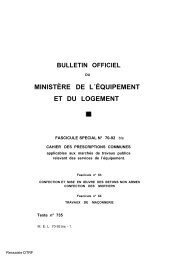Aviation Civile
Aviation Civile
Aviation Civile
Create successful ePaper yourself
Turn your PDF publications into a flip-book with our unique Google optimized e-Paper software.
12 SuSTAINAbLE DEVELoPMENT<br />
13<br />
synergy The European AIRE agreement promotes an environmental<br />
approach in the air transport sector. The exemplarity of the actions<br />
undertaken and the success of their evaluations are built on a total<br />
mobilisation of human resources and services.<br />
environment:<br />
an exemplary approach<br />
setting up a programme of evaluation<br />
flights to accelerate the<br />
development, approval and use<br />
of procedures consistent with<br />
sustainable development? This<br />
is the objective of the agreement, signed<br />
in June 2007, between the European<br />
Commission and the American Federal<br />
<strong>Aviation</strong> Authority (FAA), in order<br />
to launch the Atlantic Interoperability<br />
Initiative to Reduce Emissions (AIRE).<br />
The SESAR joint undertaking (Single<br />
European Sky ATM Research) (read also<br />
p. 10) is the technological part of the<br />
future single European sky. It is also<br />
managing the AIRE initiative.<br />
In France DSNA 1 , ADP (airports of<br />
Paris) and Air France are working<br />
together to conduct the necessary<br />
assessments in French airspace. This<br />
is enable by the contracts that have<br />
been co-financed by the SESAR joint<br />
undertaking and these three partners<br />
(Air France is working with the others<br />
for the oceanic flights). These are fullsize<br />
evaluations, conducted in realtime,<br />
with real traffic, and not mere<br />
simulations.<br />
Hence close cooperation is absolutely<br />
necessary between the partners and<br />
all of the services concerned: “At DSNA<br />
the evaluations made in 2009 on transoceanic<br />
flights 2 out of Roissy/Charles de<br />
Gaulle to Miami involved the tower and<br />
the approach to the airports of departure<br />
and arrival in France (Paris-CDG), and<br />
also the North, West and South-West<br />
CRNA 3 , explains Alain Bourgin, assistant<br />
to the head of Environment mission<br />
head at DSNA. Similarly for the evaluation<br />
flights between Orly and the West Indies,<br />
in 2010 and 2011, under the responsibility<br />
of Air France.”<br />
Aiming for the optimum<br />
In the latter case, by reducing the<br />
vertical separation standards for aircraft<br />
over the Atlantic, using on-board<br />
© Photothèque STAC/T. Jullien<br />
technologies, we can fly closer to the<br />
optimum altitudes, and so less fuel is<br />
consumed. “Effectively a flight that is<br />
fixed at 3,000 feet below its optimum<br />
means a 4% overconsumption of fuel,<br />
emphasises Laurent Renou, ATM (Air<br />
Traffic Management) Manager at Air<br />
France. In this example, being able to<br />
fly at this level saves 1.6 tonnes of fuel<br />
from the 40 tonnes for a crossing, and so<br />
5 tonnes of CO 2 .”<br />
For AIRE II, the second edition, eighteen<br />
projects have been selected by<br />
SESAR. Four involve French organisations.<br />
There are three RANCs (regional<br />
air navigation centres) and three Air<br />
Navigation Services (ANS) involved.<br />
Other than the liaisons between<br />
Orly and the West Indies, there is a programme<br />
for the daily “shuttle” flights<br />
between Orly and Toulouse. There is<br />
another for the continuous decent<br />
approach to CDG (up to 200/300 kg less<br />
fuel per flight for long haul aircraft).<br />
At CDG, optimisation of the vertical<br />
profiles of arrivals, and operations in<br />
degraded conditions, are also being<br />
studied.<br />
This time we try to make best use of<br />
the concept of A-CMD (Airport-Collaborative<br />
Decision Making), set up at CDG<br />
airport 4 in 2010. The concept optimises<br />
the use of capacity and resources and<br />
reduces taxiing time by better coordination<br />
between the players of the platform.<br />
So once again, fuel consumption<br />
and pollution can be reduced. This was<br />
evaluated in 2009-2010. “This was a challenge<br />
for a large airport like CDG, notes<br />
Olivier Delain, head of the air navigation<br />
mission at ADP. It would not have been<br />
possible without the total commitment<br />
of the staff, particularly the air traffic<br />
controllers.”<br />
This finding can be applied all the<br />
players: “With AIRE, a citizen aware of<br />
environmental issues can be in complete<br />
agreement with how the technician<br />
is doing his daily work,” reflects<br />
Laurent Renou.<br />
germain Chambost<br />
1/ Department of air navigation services.<br />
2/ Read <strong>Aviation</strong> <strong>Civile</strong> No.353.<br />
3/ Air navigation regional centre.<br />
4/ Read <strong>Aviation</strong> <strong>Civile</strong> No.356.<br />
3 4<br />
1_Guidance on a parking area.<br />
2_Refuelling an aircraft.<br />
3_Control tower of Roissy/Charles de Gaulle airport.<br />
4 _Air France aircraft at Toulouse airport .<br />
<strong>Aviation</strong> <strong>Civile</strong> magazine No.358_ June 2011 <strong>Aviation</strong> <strong>Civile</strong> magazine No.358_ June 2011<br />
1<br />
2<br />
© ADP/P. Sroppa/Studio Pons © ADP/P. Sroppa/Studio Pons<br />
© P. Garcia/Aéroport Toulouse-Blagnac<br />
Constraints<br />
and comfort<br />
the AIrE programme procedures<br />
get the best from aircrafts’<br />
on-board resources, ground<br />
equipment, and the men and<br />
women that use them.<br />
“AIRE is not really a revolution, points out Laurent<br />
Renou, Air Traffic Manager (ATM) at Air France.<br />
It consists in the first place in using the existing<br />
technology better: the equipment on the aircraft, air<br />
traffic control systems and the ground infrastructures.<br />
In a way, it is all about looking for the economic<br />
optimum with the resources at our disposal<br />
and minimising fuel consumption which ipso facto<br />
means an ecological optimisation. And finally, this<br />
approach will make the work of the teams easier.”<br />
The air traffic controllers are being directly asked<br />
to authorise monitored continuous descent<br />
approaches to the airport (CDG, Toulouse, Orly),<br />
but without giving any sort of priority to those<br />
approaches nor disturbing the other arrivals.<br />
“We have to make gains without causing problems<br />
elsewhere,” summarises Laurent Renou.<br />
As a result, pilots and passengers both win.<br />
The passengers can enjoy an uninterrupted<br />
descent, and the pilots are spared from<br />
the constraints of an arrival in successive flight<br />
levels. They are thus becoming more aware<br />
of these daily constraints and see that they can be<br />
eliminated, if the circumstances allow.<br />
Result: there is a better mutual understanding<br />
between air transport players, and of their<br />
respective roles and functions.<br />
AIRE GATHERS MoMENTuM<br />
Signed on 18th of June 2007, the AIRe agreement<br />
was initiated in 2009. During that year seventeen<br />
partners—airlines, air navigation service providers,<br />
industrial firms, airport operators, etc.—were involved<br />
in the evaluation flights (1,152 in total).<br />
For 2010-2011, AIRE II has forty-two partners,<br />
with eighteen distinct projects. In total eleven countries<br />
are involved: Austria, belgium, Canada, the Czech<br />
Republic, Germany, Morocco and Switzerland<br />
have now joined the four of AIRE I (France, Portugal,<br />
Spain and the united States).





